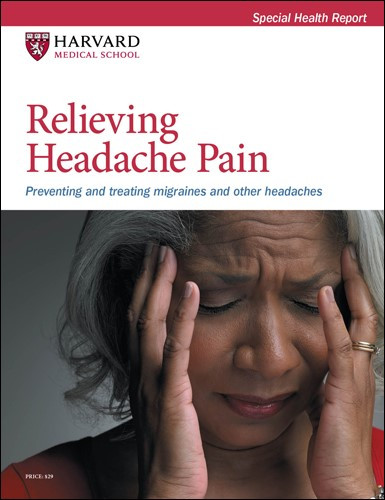The worst headache of your life
In some people, sudden, excruciating headache pain could signal a leaking or burst aneurysm.
- Reviewed by Anthony L. Komaroff, MD, Editor in Chief, Harvard Health Letter; Editorial Advisory Board Member, Harvard Health Publishing
 A terrible headache, like a migraine, can ruin your day and sideline you from activities. But the "worst headache of your life" is potentially much more dangerous. It's known as a "thunderclap headache" when the pain intensity surges within seconds to minutes. This worrisome symptom can be caused by a brain aneurysm — a weak spot on a brain artery that bulges like a little bubble on a hose.
A terrible headache, like a migraine, can ruin your day and sideline you from activities. But the "worst headache of your life" is potentially much more dangerous. It's known as a "thunderclap headache" when the pain intensity surges within seconds to minutes. This worrisome symptom can be caused by a brain aneurysm — a weak spot on a brain artery that bulges like a little bubble on a hose.
If that bubble ever leaks or bursts, it causes sudden, severe pain and bleeding that can be life-threatening. It requires an immediate call to 911.
Who gets them?
At any given time, up to 15 million people in the United States are believed to have brain aneurysms. But the aneurysms are hard to detect. They don't usually cause any symptoms unless they grow very large and push against nerves or unless they leak or rupture (which happens to about 30,000 people per year).
To complicate matters, we don't know who'll develop a brain aneurysm. Most cases occur randomly and can happen to anyone at any age. Less frequently, brain aneurysms run in families. Risk factors for brain aneurysms include being female, older than 50, or a current smoker; having high blood pressure; and having a family history of brain aneurysms.
Why they rupture
Most of the time, brain aneurysms don't burst. In fact, you can have one your whole life and never know it.
But certain features or lifestyle habits contribute to the risk of a rupture. "The feature that is most predictive of rupture is the size of the aneurysm. Chronic high blood pressure and smoking may also lead to increased growth and rupture of the aneurysm," says Dr. Rose Du, director of cerebrovascular surgery at Harvard-affiliated Brigham and Women's Hospital.
Rupture symptoms
When an aneurysm leaks or ruptures, it changes the pressure inside the skull. Normal pressure is very low. But as blood leaks out of the aneurysm and into the space around the brain, pressure skyrockets, causing damage, swelling, fluid buildup, and sudden, severe pain. "Pain doesn't creep up; it's explosive and affects your entire head, not just one side or one spot," Dr. Du says. "It's unlike any headache you've had before."
If the rupture is large, you also could become confused, nauseated, or sleepy. You may get blurry vision or a stiff neck, lose consciousness, and even slip into a coma. It could be fatal.
If the leak is very small, Dr. Du says you'll experience sudden, severe headache pain, but probably not the other symptoms. You'll eventually feel better (in days to weeks) and you might assume that the event was just a horrible migraine.
But it's important to note that a migraine comes on slowly. A headache from a brain aneurysm is sudden: five minutes ago you were perfectly fine, and suddenly you're in agony.
Preventing brain aneurysm rupturesWhen an unruptured brain aneurysm is discovered — typically during imaging tests for other medical conditions — you may have several treatment options. "First we have to decide if there's a high or low risk of rupture. That depends on your family history and the size and location of the aneurysm. If the aneurysm is small, we may just observe it periodically to make sure it isn't growing," says Dr. Rose Du, director of cerebrovascular surgery at Brigham and Women's Hospital. If the rupture risk is high, and the aneurysm is about 5 millimeters wide or more, Dr. Du says your doctor may recommend a procedure to stop the flow of blood to the aneurysm. One option is traditional open brain surgery, during which doctors install a tiny clip at the neck of the aneurysm, where it meets the artery. Other procedures are less invasive, performed by threading a catheter (a long, thin tube) up through an artery and into the brain, where doctors can insert devices to route blood flow away from the aneurysm or materials that cause a blood clot to form in the aneurysm. The newest is an intrasaccular embolization device. It's basically a three-dimensional mesh shape, like a ball. You put it into the aneurysm to keep blood from going in," Dr. Du says. She also recommends making lifestyle changes, such as getting blood pressure under control and quitting smoking. "If you quit smoking," Dr. Du says, "your risk of rupture will go down." |
Treating ruptured aneurysms
Don't try to determine what type or degree of "thunderclap" headache you're experiencing. Any sudden, very severe headache is considered a life-threatening medical emergency and needs to be investigated at an emergency department as soon as possible.
When the headache is due to a leaky or burst brain aneurysm, you might need to have fluid drained from the brain, and you might be eligible for a procedure to close off the aneurysm, depending on your condition.
This might be performed with traditional open brain surgery or a less invasive procedure that involves inserting a catheter (a long, thin tube) up through an artery and into the brain.
Prognosis
It's important to emphasize that only a small minority of brain aneurysms rupture. And if one does, the person often survives, and may even recover completely.
"We now have a lot of very safe and effective treatments, and our critical care has steadily improved over the years so that most of our patients recover well afterward," Dr. Du says. "The key is seeking care as soon as possible."
Image: © Sebastian Kaulitzki/Science Photo Library/Getty Images
About the Author

Heidi Godman, Executive Editor, Harvard Health Letter
About the Reviewer

Anthony L. Komaroff, MD, Editor in Chief, Harvard Health Letter; Editorial Advisory Board Member, Harvard Health Publishing
Disclaimer:
As a service to our readers, Harvard Health Publishing provides access to our library of archived content. Please note the date of last review or update on all articles.
No content on this site, regardless of date, should ever be used as a substitute for direct medical advice from your doctor or other qualified clinician.
















